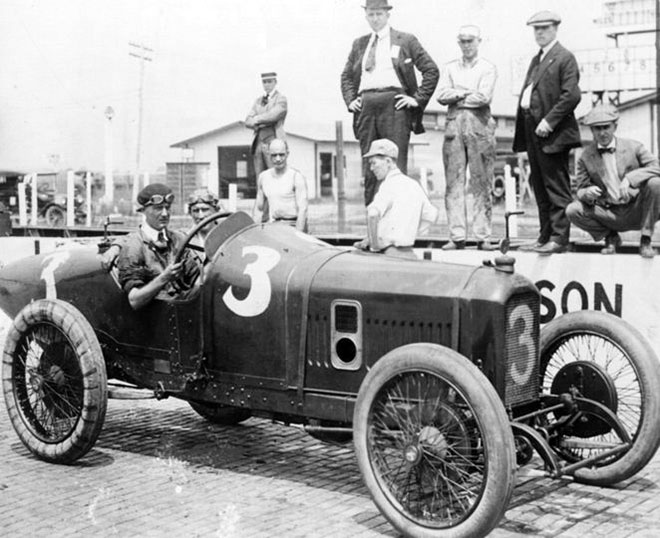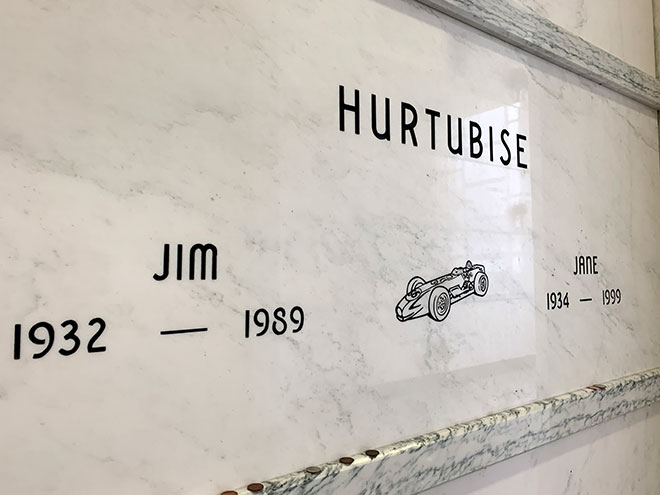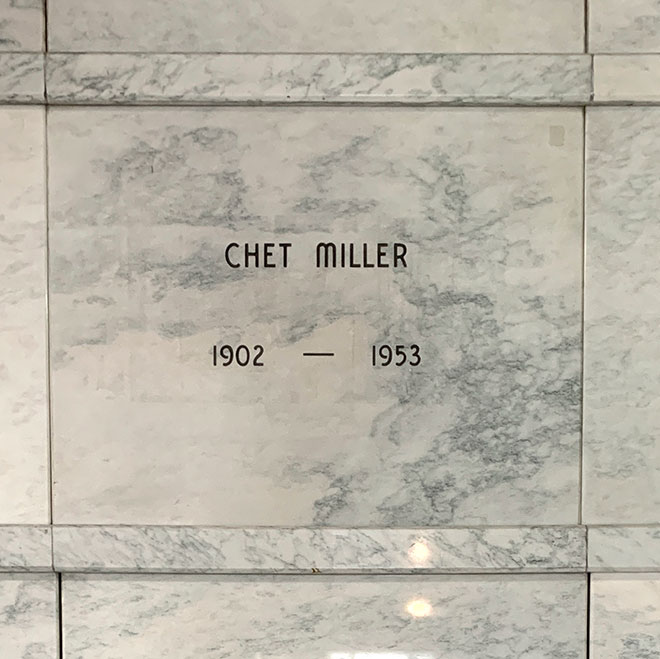The Racing Legends Resting at Crown Hill
With the Indianapolis 500 revving up around the corner, now is the perfect time to shed light on the racing legends buried at Crown Hill. Meet four of the race’s most storied drivers.
Howard “Howdy” Wilcox (1889-1923)
 There are two Indy 500 winners and one co-winner buried at Crown Hill. The earliest winner, Howdy Wilcox, drove in eleven 500s from 1911-1923, winning in 1919. It was a difficult race that year in which three drivers died, but it is also happily remembered for starting a Speedway tradition. When Wilcox crossed the finish line with the first American win since 1912, someone in the band struck up “Back Home Again in Indiana.”
There are two Indy 500 winners and one co-winner buried at Crown Hill. The earliest winner, Howdy Wilcox, drove in eleven 500s from 1911-1923, winning in 1919. It was a difficult race that year in which three drivers died, but it is also happily remembered for starting a Speedway tradition. When Wilcox crossed the finish line with the first American win since 1912, someone in the band struck up “Back Home Again in Indiana.”
Wilcox himself died in a racing accident in Pennsylvania and was buried by a baby daughter and his wife, who had both preceded him. But a son who survived them, Howdy Wilcox, Jr., was raised by a grandmother and went on to create the “Little 500” bicycle race at Indiana University. He was also a major player in starting the 500 Festival activities that are now such a big part of the month of May in Indianapolis.
Location: Section 56, Lot 240; GPS (39.8215766,-86.1781428)
(Howard Wilcox, Jr. (1920-2002) is in the Community Mausoleum F-16-2A.)
James Hurtubise (1932-1989)
 Born of Canadian parents, Hurtubise proved himself a skillful driver with a popular following despite having mostly bad luck in his nine Indy 500 races from 1961-1974, never finishing better than 13th. His worst luck came in a 1964 race in Milwaukee, when an accident left his hands severely burned. Knowing he would never again have full use of them, doctors asked him what position he wanted them to be permanently set in during surgery. He answered to have them bent so he could grip the wheel of a racecar. His return to racing earned him a “Most Courageous Athlete Award” from several sports writers.
Born of Canadian parents, Hurtubise proved himself a skillful driver with a popular following despite having mostly bad luck in his nine Indy 500 races from 1961-1974, never finishing better than 13th. His worst luck came in a 1964 race in Milwaukee, when an accident left his hands severely burned. Knowing he would never again have full use of them, doctors asked him what position he wanted them to be permanently set in during surgery. He answered to have them bent so he could grip the wheel of a racecar. His return to racing earned him a “Most Courageous Athlete Award” from several sports writers.
Location: Community Mausoleum D-8-2DD
Chet Miller (1902-1953)
 By the time he died in a practice day crash in 1953, Chet Miller had raced in 16 Indianapolis 500 races, a record he shared with A. J. Foyt until he drove in his 17th in 1974. But it may have been his first race in 1930 that was the most memorable. The Ford he was driving broke a spring early in the race. Unable to find a spare in their garage, he and his mechanic walked through the parking lot until they found an acceptable Model T, jacked it up and borrowed its spring, leaving a message for the car’s owner. Miller managed to get back in the race and finish 13th. Then they hustled to put the spring back in the Model T, offering the owner some cash for the wear and tear. But the owner refused the cash, elated that a piece of his car had finished the Indianapolis 500.
By the time he died in a practice day crash in 1953, Chet Miller had raced in 16 Indianapolis 500 races, a record he shared with A. J. Foyt until he drove in his 17th in 1974. But it may have been his first race in 1930 that was the most memorable. The Ford he was driving broke a spring early in the race. Unable to find a spare in their garage, he and his mechanic walked through the parking lot until they found an acceptable Model T, jacked it up and borrowed its spring, leaving a message for the car’s owner. Miller managed to get back in the race and finish 13th. Then they hustled to put the spring back in the Model T, offering the owner some cash for the wear and tear. But the owner refused the cash, elated that a piece of his car had finished the Indianapolis 500.
Location: Community Mausoleum B-19-A.
Erwin George “Cannon Ball” Baker (1882-1960)
 One of the first events held at the Indianapolis Motor Speedway when it opened in August 1909 was a 10-mile motorcycle race won by Erwin Baker, already dubbed the “Daredevil Indianapolis Rider.” Soon, in addition to racing on tracks, he was racing cross-country both by motorcycle and by car. In 1914, he rode his Indian Motorcycle across the USA in 11 days, 11 hours and 11 minutes, a feat then so impressive that a reporter called him Cannon Ball Baker, a name Erwin eventually copyrighted. Even President Hoover remarked that more people knew the name of Cannon Ball than the name of Herbert Hoover.
One of the first events held at the Indianapolis Motor Speedway when it opened in August 1909 was a 10-mile motorcycle race won by Erwin Baker, already dubbed the “Daredevil Indianapolis Rider.” Soon, in addition to racing on tracks, he was racing cross-country both by motorcycle and by car. In 1914, he rode his Indian Motorcycle across the USA in 11 days, 11 hours and 11 minutes, a feat then so impressive that a reporter called him Cannon Ball Baker, a name Erwin eventually copyrighted. Even President Hoover remarked that more people knew the name of Cannon Ball than the name of Herbert Hoover.
By 1933, he had trimmed his cross-country trek to a record 53 hours and 30 minutes. The 30 minutes was for his one rest stop, he said. After 3.5 million collision-free miles, he pretty much stopped speeding down the road and settled into a home across the street from Garfield Park. But in 1947, he became the first commissioner for NASCAR, a post he held until his death in 1960.
Location: Section 60, Lot 150; GPS (39.8242284,-86.1674395)

